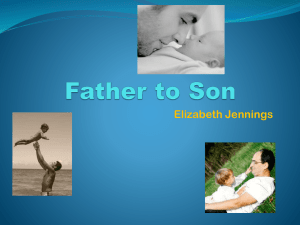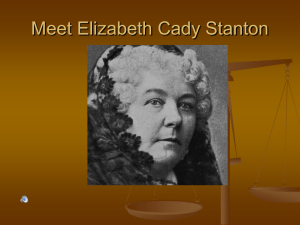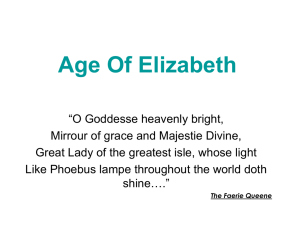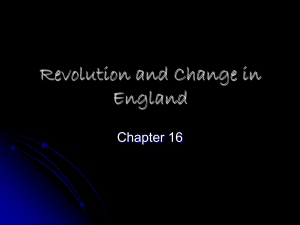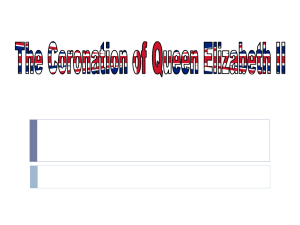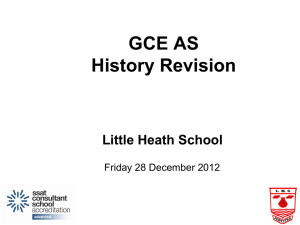The Bluestocking Society Powerpoint
advertisement
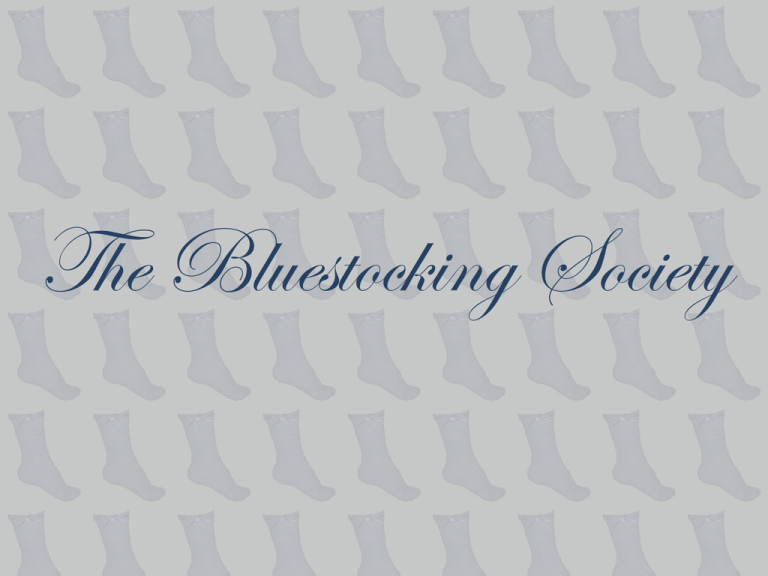
The Bluestocking Society What is the Bluestocking Society? - In the 1750’s, they were informal gatherings of both upper class and professional middle class women and men in the London homes of wellto-do society women. - It was an interlinked network of literary salons notable for encouraging intelligent conversation between women and men - They replaced the normal ‘cards and alcoholic drinks’ with tea and intellectual conversations What is the Bluestocking Society? - They engaged in a wide range of philanthropic, social and cultural activities, such as: - rescuing fallen women - establishing houses of industry for the poor and disabled - organizing subscriptions for published works by deserving authors What’s in a Name? - The term ‘bluestocking’ is thought to allude to Bishop Benjamin Stillingfleet, a gentleman intellect and scientist, who wore informal blue worsted stockings to a meeting instead of formal white or black silk stockings - Originally, the term referred to the male participants, but by the 1770s it included the female members, and eventually was used primarily or exclusively to refer to the women of the society. - Original name was the Bluestocking Circle. - Several variants of the name used as half-mocking commentary Bluestocking Club -- Alluded to gentlemen’s clubs from which women were excluded -- In recognition of the circle’s parallel contribution to civil society Bluestocking Lodge -- like lodges of exclusively male secret societies, such as the Freemasons -- in recognition of the circle’s parallel function in providing opportunities of mutual interests and common causes Colledge -- referred to institutes of higher education, from which women were denied access -- in recognition of the circle’s interest in intellectual life and the promotion of scholarship, literature, and culture Bluestocking Philosophy Meant a commitment to the intellectual companionship of men and women against the common relations exemplified by courtly gallantry and sexual intrigue supposed to be characteristic of the upper class codes, conventions and practices The Function of the Bluestocking Society - The Bluestocking Circles were well connected within the established order, and had such a vested interest in it that they resisted any radical change to it (i.e. Jacobite Revolution of 1745-6, War of Austrian Succession) - Since the women of the Bluestockings were excluded from politics, church, state, etc… they directed their reforming energies into moderation/modification of the established order, or those aspects they could reach. Bluestocking Feminism - The Bluestocking movement was feminist inasmuch as it promoted the interests of women within the established social, economic, and cultural order, as that order was being transformed in various ways in the middle and latter part of the eighteenth century in England - It drew on the Renaissance tradition of the ‘learned lady’ in upper and upper middle-class society - Bluestocking women had to negotiate carefully between sexist social conventions, legal restrictions on women’s property and rights, the gendered nature of the wandering order, and theorised gender inequality in the conduct book tradition Evolution of the Name - The term ‘bluestocking’ became generalized - It tended to be used by those who either feared or felt excluded from Bluestocking society, or who suspected that the Bluestockings circle was a cover for sexual flirtation or even intrigue of kinds associated with courtly society - It became an increasingly derogatory term, used within a broad reaction against women’s pursuit of intellectual life and social usefulness beyond mere domesticity, at least in the upper and middle classes The Women of the Bluestocking Society Elizabeth Montagu Elizabeth Vessey Frances Boscawen Hannah More Anna Laetitia Barbauld Sarah Fielding Catherine Talbot Elizabeth Carter Hester Chapone Frances Burney Sarah Scott Anna Seward Hester Thrale Catherine Graham Amongst others….. Birthplace Location Map The map below depicts the birthplaces of some of the Bluestocking members. All of these women became involved in Bluestocking work and membership after moving to the London area at some point. A large number of these women moved to the London area in pursuit of the London literary society. Bluestocking Year Birthplace Frances Boscawen 1719 St. Clere, Kent, England Elizabeth Carter 1717 Deal, Kent, England Hester Chapone 1727 Twywell, Northamptonshire, England Sarah Fielding 1710 East Stour, Dorset, England Catherine Graham 1731 Wye, Kent, England Elizabeth Montagu 1721 York, Yorkshire, England Hannah More 1745 Stapleton, Gloucestershire, England Sarah Scott 1721 York, Yorkshire, England Anna Seward 1741 Eyam, Derbyshire, England Catherine Talbot 1721 Berkshire County, England Hester Thrale 1741 Bodvel, Caernarvonshire, Wales Elizabeth Vesey 1715 Ossory County, Ireland Queen of the Blues Elizabeth Montagu – 1720-1800 Author and Literary Hostess Elizabeth Montagu was born in 1720 in York, Yorkshire to Elizabeth and Matthew Robinson Elizabeth was the oldest child, and received the nickname “Fidget” from her family Elizabeth and her siblings spent long periods of time with their Grandparents, Dr. and Mrs. Middleton in Cambridge and it is thought that she received her introduction to classical and English literature and history during her stays with them John Sawbridge and Sarah Scott, Elizabeth’s siblings, both ended up involved in writing In 1742, Elizabeth married Edward Montagu, and had a son John, who died in 1744- his death devastated Elizabeth In 1775, her husband died, leaving his entire estate to Elizabeth; except for £3000, which he left to Matthew Robinson, the second son of Elizabeth’s brother Morris; Elizabeth’s inheritance was reported to be worth £7000 a year In 1776, Elizabeth adopted Matthew and he took the surname Montagu Elizabeth died in 1800 at Montagu house, Portman square, leaving her entire estate to Matthew Queen of the Blues - Her parties began as simply literary breakfasts - By 1760, these literary breakfasts had become large evening assemblies that did not allow heavy drinking or card playing - It was encouraged that guests exchange witty conversation on literary and philosophical subjects - Elizabeth’s writing and publication was minimal compared to other members of The Bluestockings, but she was credited as the “Queen of the Blues” because her role as hostess, facilitator, and sponsor made her an integral part of the development of the Bluestocking culture - Elizabeth was viewed by her contemporaries as the perfect example of how a woman could be intellectual, moral, and a useful member of society - Elizabeth did have some writings; most of which were letters Montagu’s Writing In 1769 she published An Essay on the Writings and Genius of Shakespeare The essay defended Shakespeare against the attacks of critics such as Voltaire and Samuel Johnson (whose Preface to Shakespeare had appeared in 1765). Montagu had some not so nice words against Johnson and his work, and the publishing of her Essay injured her relationship with Johnson on a personal level. Other Ladies Elizabeth Carter (1717-1806) -most prolific member of the first generation Bluestockings - wrote letters, poems, translations and essays -Poems on Particular Occasions -An Examination of Mr. Pope’s Essay on Man -Sir Isaac Newton’s Philosophy Explain’d for the use of Ladies -All the Works of Epictetus that are now Extinct Hester Chapone (1727-1801) -wrote the most noteworthy and widely read work of the first generation Bluestockings - Letters on the Improvement of the Mind: Addressed to a Young Lady Hannah More (1745-1833) - Wrote one of the most important Bluestocking works; Bas Bleu: Or, Conversation - It was the first account of the Bluestockings to be published from within the Bluestocking circle itself -The poem condemns the women who set the taste for the seventeenth-century salon, and outlines a different standard for the eighteenth century British salon, as More expressed in her poem that communication was in danger of being overrun by the addiction of card playing, drinking, and dancing that society was facing: Long was Society o’er-run By Whist, that desolating hun; Long did Quadrille despotic sit, That Vandal of colloquial wit; And Conversation’s setting light Lay half-obscur’d in Gothic night. -The poem was addressed to Elizabeth Vesey and More presented her, Elizabeth Montagu, and Frances Boscawen as the three Bluestocking saviours, all of whom could restore the integrity to polite society: At length the mental shades decline, Colloquial wit begins to shine; Genius prevails, and Conversation Emerges into Reformation. -More’s poem has remained the most significant defense of the Bluestocking ideals Men of the Bluestockings The Bluestocking Society meetings were primarily for women, but men were also invited. Notable men of the Bluestockings: Benjamin Stillingfleet may have been the source behind the name. Most notably, Samuel Johnson had attended Bluestocking Society meetings. This would have been until his and Elizabeth Montagu’s friendship was affected by her publication defending Shakespeare. Others - Horace Walpole, Edmund Burke, James Beattie, David Garrick, William Pulteney, and Joshua Reynolds The Bluestockings in Art Portraits in the Characters of the Muses in the Temple of Apollo by Richard Samuel include Elizabeth Carter, Angelica Kauffman, Anna Letitia Barbauld, Catharine Macaulay, Elizabeth Montagu, Elizabeth Griffith, Hannah More, Elizabeth Ann Sheridan and Charlotte Lennox. But not all of the art depicting the Bluestocking Society was flattering... This frenzied scene is a hand-coloured etching done by Thomas Rowlandson in 1815. Rowlandson depicts in this etching, a stereotypical view of what happens when female gossips are left alone; a scene very different from the civilized tea and conversation promoted by the Bluestockings. The Critics • • • • • Montagu was satirised by Lord Byron as the ridiculous Lady Bluebottle in his Literary Eclogue of 1821 he had a dig at woman poet Felicia Dorothea Hemans too, suggesting she should ‘knit bluestockings instead of wearing them’ (possibly motivated by the fact that Hemans was a more popular and better-selling poet than he was at the time). French satirical cartoonist Honoré Daumier created a series of etchings of grotesque women scholars, Les Bas Bleus, aimed squarely at liberated femmes like novelist George Sand, and Hannah More’s poem of the similar title. Fanny Burney, a bluestocking member herself, wrote her first play The Witlings about pretentious patrons of the arts Mrs Voluble, Mrs Sapient and the regal Lady Smatter. The satire came close to being staged by Sheridan at Drury Lane, until her father persuaded her to pull it before it got her into trouble with Montagu. As the tide turned against the dangerously unfeminine bluestockings, depictions became more sinister, such as the character of mannish feminist Harriet Freke, said to be based on radical writer Mary Wollstonecraft, in Maria Edgeworth’s 1811 novel Belinda, who meets her come-uppance in a man-trap. The Bluestocking Legacy The Bluestocking Society has had far reaching effects not just in Europe, but all around the world. All forms of feminism can find some sort of tie back to the Bluestockings, whether they are radical opposites or not. There is even a Bluestocking Society today, located in London….. The Bluestocking Cabaret A London Burlesque Show “For thinking women and the men who love them” Questions to ask yourself…or talk about in class…. - What do YOU think about the Bluestocking Society? - Would you brand the society as Feminist? - If so, with the positive or negative connotation the title can carry? - Are you surprised that men were included in the Bluestocking Society gatherings? - What is your opinion of the Bluestockings Cabaret? Is it an inspired homage or is it disrespectful to the legacy of the Bluestocking Society? Works Cited Kelly, Gary, Elizabeth Eger, Judith Hawley, and Rhoda Zuk. Bluestocking Feminism: Writings of the Bluestocking Circle, 1738-1785. Charlottesville, Va: InteLex Corp, 2004. Internet resource. http://bluestockingssociety.wordpress.com/ http://en.wikipedia.org/wiki/Blue_Stockings_Society
